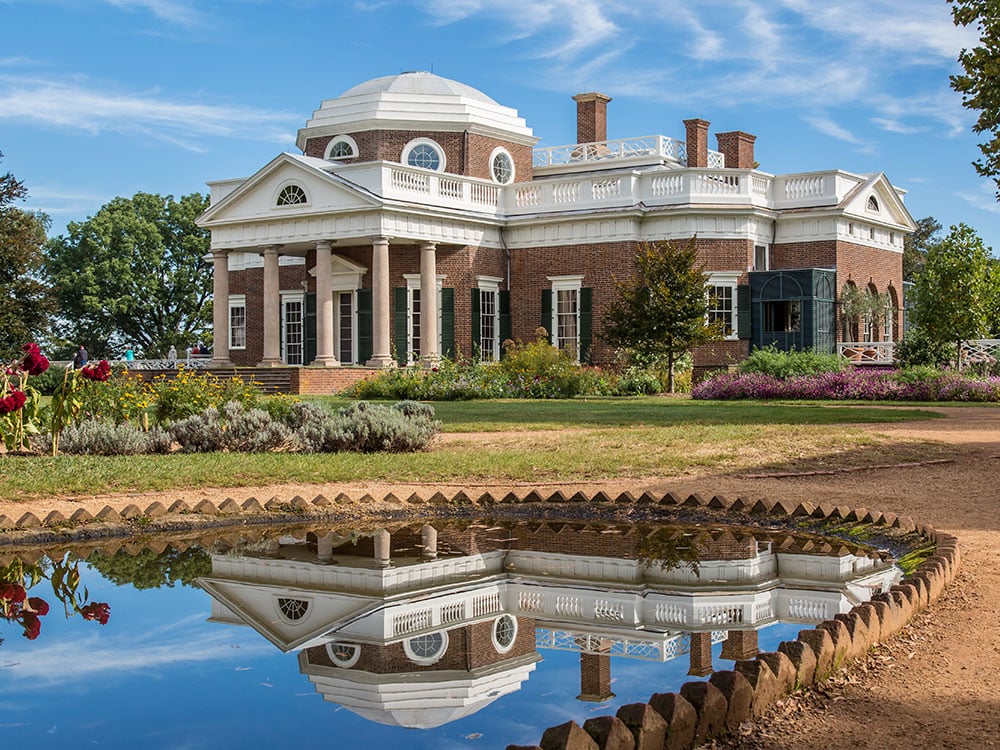Math Lesson | 10 Homes
Math Lesson
Geometric modeling

Overview
In this lesson, students will learn about three dimensional and two dimensional modeling and geometry.
Time: 2 - 3 periods
STANDARDS
This lesson addresses selected standards from the Common Core mathematics standards.
- Apply geometric concepts in modeling situations.
CCSS.MATH.CONTENT.HSG.MG.A.1. Use geometric shapes, their measures, and their properties to describe objects. - Visualize relationships between two-dimensional and three-dimensional objects.
CCSS.MATH.CONTENT.HSG.GMD.B.4. Identify the shapes of two-dimensional cross sections of three-dimensional objects, and identify three-dimensional objects generated by rotations of two-dimensional objects.
Preparation
To prepare to teach this lesson, teachers should:
- Watch Monticello segment from the PBS special 10 Homes that Changed America, on DVD or online.
- Review the lesson plan.
- Download and print copies of photo of Monticello, and plan of Monticello.
- Download and print copies of worksheet.
- Gather various three-dimensional cardboard boxes, such as cereal boxes, tissue boxes, paper-towel and toilet-paper tubes, cylindrical oatmeal tubes, etc.
Lesson
Materials:
- Copies of Monticello photograph (front view, i.e., elevation)
- Copies of plan of Monticello
- Overhead projector, Elmo, or computer and digital projector or Smartboard
- Worksheets
- Pencils
- Scissors
- Rulers (to measure and to use as a straight edge)
- Thin cardboard (You may use empty cereal boxes that the students bring in from home. Just open them up and students may cut out the different shapes.)
- Masking tape
- Glue (thick, liquid glue like Tacky Glue)
- Glue stick
- Sturdy pieces of cardboard (11” X 17”) for base of models.
- Card stock
Period 1
- Watch the segment about Monticello from the PBS Special 10 Homes that Changed America. Ask students what they learned about how Jefferson used geometry to create his “essay in architecture.” Project the image of Monticello using either the Elmo or the Smartboard. Ask students to identify the shapes they observe. Encourage them to describe both the two-dimensional and the three-dimensional shapes they see. Keep a list of the students’ responses.
- Ask students if they can think of any other examples of architecture where geometric shapes are so prevalent. (Greek and/or Roman temples might come to mind, although all buildings are based on shapes.)
- Tell students that they are going to work in groups to create small models of Monticello. These models will not be decorated with windows. Nor will they be colorful. They will merely be study models so that students can understand the geometry of the building.
- Break students up into groups of four. Give each group the instruction sheet, photo of Monticello, plan of Monticello, rulers, scissors, pencils, and masking tape.
- Students begin working through the instructions on the sheet and making their models.
Period 2
- Students continue and finish model building.
- Students share their models.
NOTE: If the students have not completed their models after two periods, they may need an additional period.
Additional Resources
Books
- Geometry in Architecture by William Blackwell
- The Architectural Ideology of Thomas Jefferson by Ralph G. Giordano
- Geometry Civilized: History, Culture, and Technique by J.L. Heilbron
- Jefferson and Monticello: The Biography of a Builder by Jack Mclaughlin
Online Sources
- Monticello
www.monticello.org - Geometry of Garden Pavilion at Monticello
https://www.monticello.org/site/house-and-gardens/garden-pavilion - Geometry in Architecture
https://siarchives.si.edu/sites/default/files/pdfs/Renwick_Geometry_ Activity.pdf - The Monticello Classroom (Meant for younger students, but useful)
http://classroom.monticello.org/kids/home/
For Further Study
This Math lesson can be extended to other subjects or paired with other 10 Homes that Changed America lessons to create the following interdisciplinary connections:
- Art: Students may embellish their models with paint or apply construction paper, so that the models appear finished, with brick, marble trim, windows, etc.
- Social Studies: Students may research the architecture of Ancient Rome and/or the work of Andrea Palladio and create a visual Venn diagram that compares and contrasts Monticello with these architectural precedents.
- Science: Design an invention that would have made it easier to get water up the hill and into Monticello. Use only the technology that existed at the time.
- English Language Arts: In the show, critic Paul Goldberger notes that if Jefferson were alive today, he would be railing against McMansions. Find an image of a McMansion (or use an example in your community) and write an essay in Jefferson’s voice critiquing the architecture.

